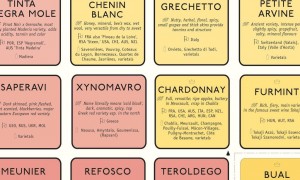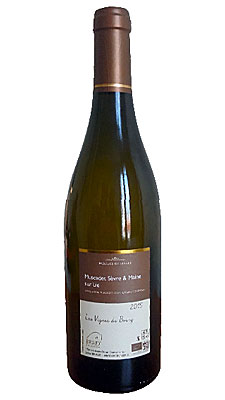When I type the word “minerality” into a tasting note, spell-check invariably bites back with an angry red underline declaring that there’s no such word.
Wine Grape
Varietal Table
Remember studying the Periodic Table of the Elements in high school? You won’t need to struggle with Steve and Deborah De Long’s Wine Grape Varietal Table.
Browse the world’s ten best value wines on Wine-Searcher.com!
This seems unfair, as I love the stony, chalky, granite, slate, clay, oystershell, or rainwater-over-rocks character that distinguishes some of the world’s most subtle and interesting wines.
In an age when many wine lovers are enthusiastic about big, juicy wines that strut their stuff with layers of ripe, jammy fruit framed by oak and high alcohol, perhaps it’s no surprise that these lean, minerally wines delight only a minority of wine enthusiasts that’s occasionally mocked as the “anti-flavor wine elite.”
These wines, often from Europe’s more traditional regions like Germany’s Mosel Valley, the Loire Valley and parts of the Northern Rhône, in France; Austria’s Wachau region in the Danube valley, and scattered smaller regions like Spain’s Priorat, don’t often make the front pages of slick wine magazines or turn up in special wine shop displays.
Curiously, this style of wine has always been with us. I’d argue that it was present, and even celebrated, before fruit-forward wines became so dominant. But the word “minerality,” however clearly it defines a style, is new. It isn’t in dictionaries (or my spell-checker), and wasn’t listed in wine encyclopedias as recently as the 1980s. It’s not included in Ann Noble’s beloved Wine Aroma Wheel (1984) or in any of the respected wine scientist Emile Peynaud‘s books.
My old Frank Schoonmaker Encyclopedia of Wine, a 1988 update of a 1975 classic that was pretty much my personal Wine 101 course, has no entry for minerality, but we can find its definition in the familiar French term terroir, which was also beginning a shift in understanding during those years. “Terroir (tair-wah’r): French for “soil” or “earth,” used in a very special sense in the phrase gout de terroir or “taste of the soil,” Schoonmaker wrote.
Indeed, for many years even many wine makers and wine scientists assumed that “terroir” represented actual flavors of the soil, taken up through the grapevine’s roots into the grapes. Thus we perceive flavors of slate in the Mosel or Priorat, granite in the northern Rhone, gneiss in the Wachau, chalk in Chablis and the Loire Valley, and so it went.
This made so much sense that it was easy to believe, but more modern science has thoroughly debunked it. The 2017 article Minerality Myths, by Master of Wine Sally Easton, offers a quick, clear overview of modern thinking on the matter.
Easton quoted Alex Maltman, professor of earth sciences at Aberystwyth University, observing that minerals in the soil are “not necessarily bio-available.” Moreover, “minerals do not vaporise – they are odourless, and their concentration in wine is far below the taste threshold.”
Easton also cited Dr. Wendy Parr, a sensory scientist from Lincoln University in New Zealand, who concluded that much of the perception of minerality is “top-down perception, that is, what’s already in our heads – memory, experience. For example, you can see Chablis on the label and you already have expectations.”
So, in short, when we confront with delight a wine that clearly seems to reveal elements of chalk, granite, slate or clay or even that delightful rainwater-on-rocks petrichor, what exactly are we tasting?
Right now, I’m looking at yeast effects. The yeast that converts grape sugars into alcohol and thus elevates grape juice into wine acts in mysterious ways, and it’s no secret that yeast can have a profound impact on wine flavor.
That goes double with wines like the Muscadet Sèvre et Maine featured in today’s tasting, below, which undergo the sur lie (“on the lees”) vinification, with the wine left to age on the lees – dead yeast sediment – rather than the usual process of being siphoned off immediately after fermentation. This long lees contact adds distinct character to the wine, and it’s easily read as chalk or stone. Combine that with a wine region on chalky soil, and it’s easy to detect a distinct chalk character, even if there’s not a molecule of chalk present.
Wine is mysterious that way, isn’t it? You’ll find my tasting report below.
Today’s Sponsor:
Wine Grape Varietal Table
 Remember studying the Periodic Table of the Elements in high school? You won’t need to struggle with Steve and Deborah De Long’s Wine Grape Varietal Table. A wine reference disguised as a fine-art print, it looks like the chemical table but replaces the elements with a world of wine grape varieties: 184 of the world’s favorite grapes organized by body and acidity, clearly showing how they relate. Buy one for a friend, or for yourself! The Wine Grape Varietal Table is $25. Click here to order now.
Remember studying the Periodic Table of the Elements in high school? You won’t need to struggle with Steve and Deborah De Long’s Wine Grape Varietal Table. A wine reference disguised as a fine-art print, it looks like the chemical table but replaces the elements with a world of wine grape varieties: 184 of the world’s favorite grapes organized by body and acidity, clearly showing how they relate. Buy one for a friend, or for yourself! The Wine Grape Varietal Table is $25. Click here to order now.
The De Longs also produce stunning, quality poster-size wine maps of France, Italy and other regions for $14.95 to $29.95. Click here to view and order any of the De Long wine maps.
Today’s Tasting Reports
Julien Braud 2016 “Les Vignes du Bourg” Muscadet Sèvre et Maine sur lie ($13.99)
Transparent light gold color, a pretty hue in the glass, perhaps an effect of Muscadet’s sur lie wine making in which the fermented yeast remains in the wine as it develops in fermenting tanks. The combination of sur lie, the chalky soil in its vineyards near the mouth of the Loire Valley, against the rather neutral palate of the Melon (“Meh-lawN”) de Bourgogne grape, pave the way for a wine of surprising complexity and flavor interest for a relatively affordable white. Notes of pears and white flowers are accented by chalky notes on the nose and a distinct minerality in the dry, gently acidic, medium-bodied flavor. Moderate 12% alcohol makes it easy to enjoy another glass; don’t serve it too cold, so you can enjoy its flavor nuances. U.S. importer: WineCRAFT, Cincinnati. (Sept. 27, 2018)
FOOD MATCH: Oysters on the half-shell are its natural match, or shellfish in general in subtle preparations. It’s good with goat cheese, too, prompting a light spinach frittata topped with dabs of mild Capriole Indiana goat cheese.
WHEN TO DRINK: Its Diam technical cork will insure against cork taint, but I’m inclined to drink up Muscadet within a few years after the vintage anyway.
VALUE:
It’s a fine value at Wine-Searcher.com’s $14 average retail. I’m tempted to go back for more.
WEB LINK
The importer’s Web page is limited to the basics; also check the WineCRAFT Facebook page.
FIND THIS WINE ONLINE:
Find vendors and compare prices for Julien Braud “Les Vignes du Bourg” Muscadet on Wine-Searcher.com.
If you can’t find this particular label near you, use this link to browse WineSearcher.com; page down to find a large variety of other Muscadets and their vendors.
More affordable wines
Want tips to more good, inexpensive wines? Here are Wine-Searcher links to vendors and prices for a bunch more wines for $10 or less that I’ve told you about during the past few months. Please tell us about your favorites!
Wine Forum and Social Media
If you have questions, comments or ideas to share about today’s article or wine in general, you’re always welcome to drop by our online WineLovers Discussion Group, the Internet’s first and most civil online community.
Discussions are open for public viewing, but you must register to post. If you’re a Facebook user, you can join our forum with a single click! All you need to do is visit the forum and click “Social Login” at upper right.
We’d also be delighted to have you visit and “Like” our WineLovers Facebook Page. This way you can get Facebook notifications when there’s a new The 30 Second Wine Advisor issue or a topic of particular interest on the WineLovers Discussion Group (WLDG).
Subscriptions and Administrivia
Unsubscribe:
We’re sorry if you must leave us, but simply click the “unsubscribe” link at the bottom of your Email edition to be instantly removed from the mailing list.
Change address:
The quickest and easiest way to change your email address is simply to unsubscribe from your old address and register again from the new one: Subscribe to The 30 Second Wine Advisor (free).
Archives:
Read nearly 20 years of past articles in the Wine Advisor Archives.
Sponsorship Opportunities:
For information, email Robin Garr at wine@wineloverspage.com






